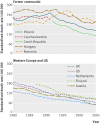Decline in mortality from coronary heart disease in Poland after socioeconomic transformation: modelling study
- PMID: 22279114
- PMCID: PMC3266431
- DOI: 10.1136/bmj.d8136
Decline in mortality from coronary heart disease in Poland after socioeconomic transformation: modelling study
Abstract
Objectives: To examine how much of the observed rapid decrease in mortality from coronary heart disease in Poland after the political, social, and economic transformation in the early 1990s could be explained by the use of medical and surgical treatments and how much by changes in cardiovascular risk factors.
Design: A modelling study.
Setting: Sources of data included controlled trials and meta-analyses, national surveys, and official statistics.
Participants: Population of adults aged 25-74 in Poland in 1991-2005.
Main outcome measures: Number of deaths prevented or postponed in 2005 attributable to specific treatments for coronary heart disease and changes in risk factors. A previously validated epidemiological model for coronary heart disease was used to combine and analyse data on the uptake and effectiveness of specific cardiac treatments and changes in risk factors. The observed fall in deaths from coronary heart disease from 1991 to 2005 was then partitioned among specific treatments and risk factor changes.
Results: From 1991 to 2005, the death rate from coronary heart disease in Poland halved, resulting in 26,200 fewer coronary deaths in 2005 in people aged 25-74. About 37% (minimum estimate 13%, maximum estimate 77%) of this decrease was attributable to treatments, including treatments for heart failure (12%), initial treatments for acute coronary syndrome (9%), secondary prevention treatments after myocardial infarction or revascularisation (7%), chronic angina treatments (3%), and other treatments (6%). About 54% of the fall was attributed to changes in risk factors (minimum estimate 41%, maximum estimate 65%), mainly reductions in total cholesterol concentration (39%) and an increase in leisuretime physical activity (10%); however, these were partially offset by increases in body mass index (-4%) and prevalence of diabetes (-2%). Blood pressure fell in women, explaining about 29% of their decrease in mortality, but rose in men generating a negative influence (-8%). About 15% of the observed decrease in mortality was attributable to reduced smoking in men but was negligible in women.
Conclusions: Over half of the recent fall in mortality from coronary heart disease in Poland can be attributed to reductions in major risk factors and about one third to evidence based medical treatments.
Conflict of interest statement
Competing interests: All authors have completed the ICMJE uniform disclosure form at
Figures



Comment in
-
The decline in coronary heart disease; did it fall or was it pushed?BMJ. 2012 Jan 25;344:d7809. doi: 10.1136/bmj.d7809. BMJ. 2012. PMID: 22279112 No abstract available.
-
Acute coronary syndromes: Reduced mortality from MI in Denmark, England, and Poland.Nat Rev Cardiol. 2012 Feb 21;9(4):186. doi: 10.1038/nrcardio.2012.16. Nat Rev Cardiol. 2012. PMID: 22348972 No abstract available.
References
-
- Wojtyniak B, Goryński P. Sytuacja zdrowotna ludności Polski. Narodowy Instytut Zdrowia Publicznego-Państwowy Zakład Higieny, 2008.
-
- Zatoński W, ed. Closing the health gap in European Union. Cancer Epidemiology and Prevention Division, the Maria Skłodowska-Curie Memorial Cancer Center and Institute of Oncology, 2008.
-
- World Health Organization, Department of Health Statistics and Informatics. The WHO mortality database. 2010. www.who.int/whosis/mort/download/en/index.html.
-
- Zatonski W, Campos H, Willett W. Rapid declines in coronary heart disease mortality in Eastern Europe are associated with increased consumption of oils rich in alpha-linolenic acid. Eur J Epidemiol 2008;23:3-10. - PubMed
Publication types
MeSH terms
Substances
Grants and funding
LinkOut - more resources
Full Text Sources
Other Literature Sources
